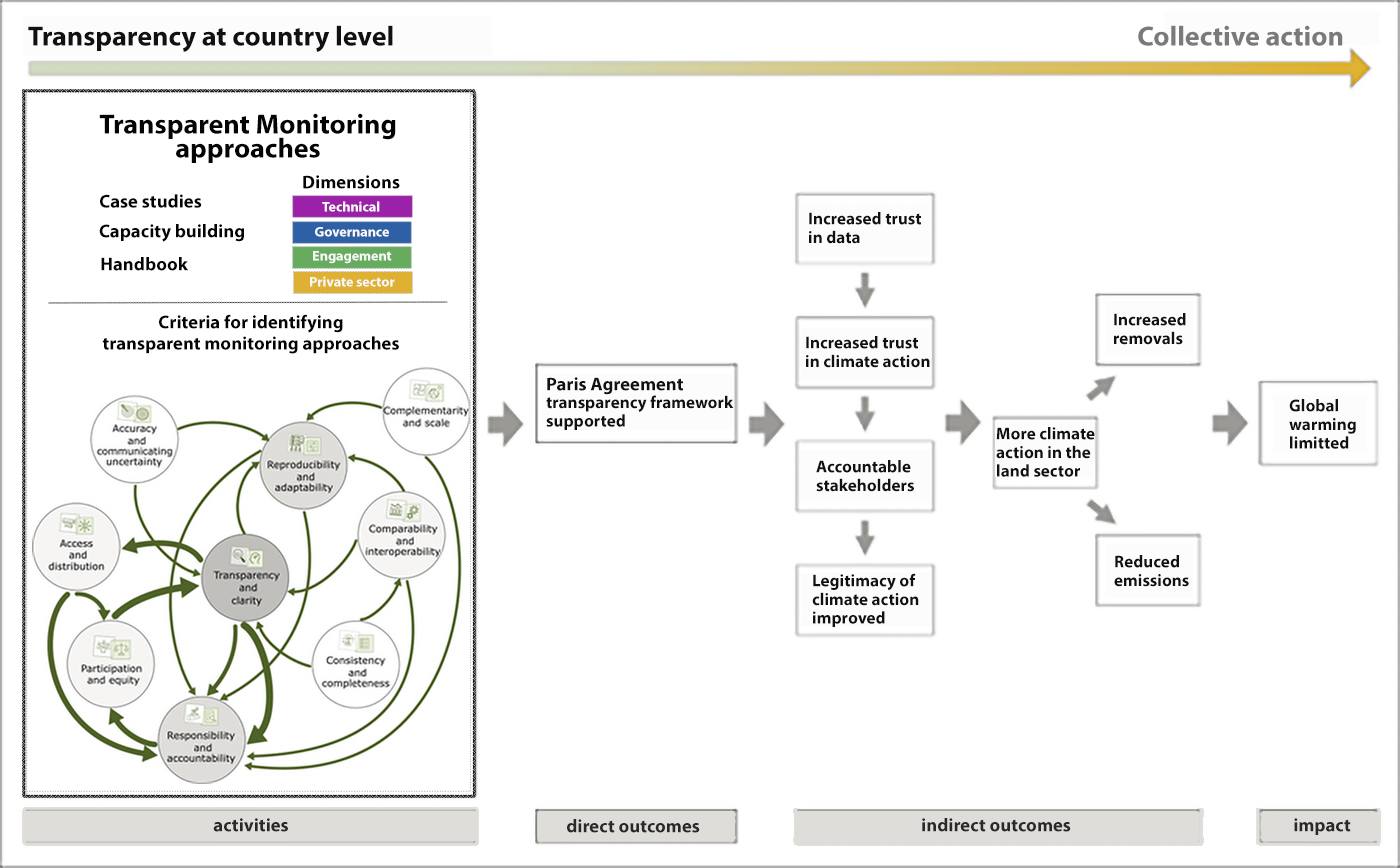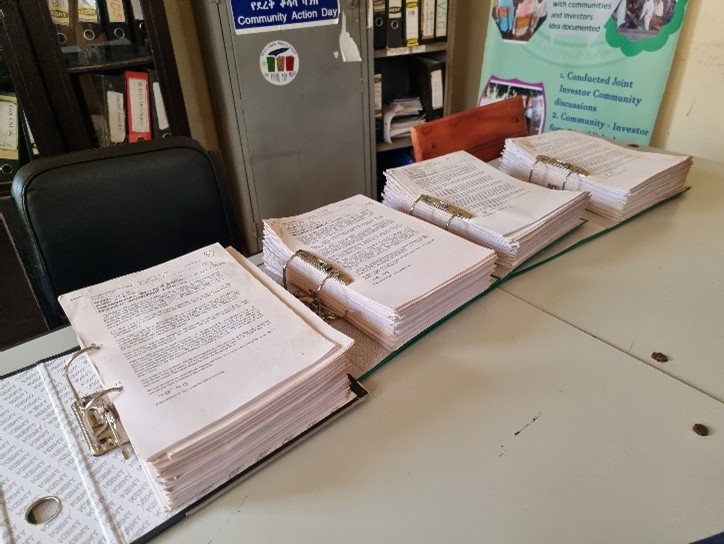About
What is transparent monitoring?
Countries have a lot of freedom in setting targets and defining the scope of their Nationally Determined Contributions (NDCs), but they also must account for emissions and removals from the sector in a manner that promotes transparency, and provides sufficient accuracy, completeness, comparability, and consistency. Transparent monitoring of greenhouse gas emissions and removals occurs when the data is managed according to these key criteria. From a global transparency perspective, the variety of country approaches for setting targets, paired with limited capacities in countries, pose a challenge to the effectiveness of national reporting and for assessing climate action in the land sector.
By taking advantage of transparent monitoring approaches, countries can increase their capacities for monitoring and reporting GHG emissions and removals from the land sector and advance in the implementation of the Paris Agreement’s Enhanced Transparency Framework (ETF).
Transparent monitoring approaches refer to datasets, tools, and portals that support countries’ needs in the land sector, by providing complementary data to what is mandated by their own monitoring systems.
They do not constitute one single system or a one-serves-all approach. Instead, the implementation of transparent monitoring approaches relies on access to a diversity of inter-operable methodologies, datasets and tools. Transparent monitoring approaches can also help to anticipate, identify, and resolve potential conflicts or discrepancies between datasets.
We identified the theory of change described in the Figure below, that can support the implementation of the ETF under the Paris Agreement and thus increase trust in data and climate action.

How to navigate this website
Information on this site is modeled from the guide, Transparent monitoring in practice: A guide to effective monitoring in the land sector
Book I Background for understanding transparent monitoring approaches: An introduction to Transparent Monitoring gives an overview of transparent monitoring approaches, explores the criteria necessary for transparent monitoring, and reviews recent technical advancements in the sector. Book II Case studies of transparent monitoring approaches: Transparent Monitoring in practice presents evidence from 10 case studies on how transparent monitoring approaches were applied to different national contexts and the lessons learned from each engagement.
The “Criteria” page summarizes nine pairs of criteria for identifying transparent monitoring approaches and connects each of these to relevant stakeholder “dimensions” where they should be applied.
On the “Countries” page, users can explore information on the four countries where the transparent monitoring project was engaged: Côte d’Ivoire, Ethiopia, Papua New Guinea and Peru. The country profiles are also cross-linked to Book II, which explores case studies and lessons learned from these different engagements.
Transparent Monitoring in Practice
Who are the Transparent Monitoring guidelines for?
Private sector
Case studies in the private sector dimension are relevant for stakeholders aiming to implement transparent monitoring approaches in the context of corporate land use practices and supply chains, for example to show compliance with commitments on deforestation free products or the use of voluntary carbon markets. This dimension addresses issues related to
- The data sources and methods for monitoring the deforestation-free origins of commodities.
- Ensuring coherence between government MRV frameworks and private sector MRV activities.
- The quality of data used for decision-making, compliance, and reporting purposes.
- Monitoring the social and economic impact of REDD+ projects, in addition to biophysical impact monitoring.
The stakeholders mainly engaged in this dimension are companies with zero-deforestation commitments or obligations, data suppliers, including remote sensing providers, who support private sector transparency efforts with monitoring technology, and government officials working with companies on deforestation-free supply chains.
Related criteria
Transparency & Clarity
Comparability & Interoperability
Complementary & Scale
Access & Distribution
Responsibility & Accountabiliy
Community
Case studies in the community dimension are relevant for stakeholders from local and indigenous communities and those working with them. The dimension addresses the role local communities and indigenous peoples can play in the monitoring process and the arrangements needed to ensure their effective participation. This includes for example:
- the need for community-level data collection and targeted capacity building,
- the flow of information back to communities,
- a comprehensive consideration of costs and benefits associated with monitoring for the communities, for example the level of compensation or the opportunity costs for community members,
The stakeholders concerned with this dimension are mainly local communities engaging in monitoring, government officials, and civil society organisations and researchers working to support communities.
Related dimension
Transparency & Clarity
Reproducibility & Adaptability
Access & Distribution
Governance
Case studies in the governance dimension are relevant for stakeholders seeking guidance for implementing concrete national and international policies. The stakeholders’ monitoring and reporting obligations include:
- the requirement to track progress in the implementation and achievement of NDCs, and to report to the UNFCCC every two years,
- the preparation of national greenhouse gas inventories for reporting to the UNFCCC or complying with national laws,
- reporting on forest conservation and forest cover change to access results-based payments for REDD+,
- supporting policy implementation (e.g. the European Regulation on Deforestation, EUDR) and enforcement of national laws.
This dimension is mainly composed of policy makers and government officials tasked with developing and or maintaining national reporting and monitoring arrangements as well as those that ensure their country fulfils its international reporting obligations. Stakeholders from the private sector, local communities, indigenous peoples, and the scientific community may also find this dimension important, given how much government monitoring and reporting could affect their own land-use operations.
Related dimension
Transparency & Clarity
Consistency & Completeness
Reproducibility & Adaptability
Access & Distribution
Responsibility & Accountabiliy
Technical Dimesnion
This dimension relates to the technical aspects of improving monitoring in the land sector. Case studies in this dimension are relevant for stakeholders who are aiming to improve monitoring, data collection and data processing for biomass and GHG inventories. Technical considerations include:
- challenges for integrating recent technical and scientific developments in ongoing monitoring work,
- understanding possibilities and addressing limitations of different approaches to monitoring,
- the need for better collaboration between different fields of expertise,
- ensuring that results are easily accessible and useful for other stakeholders.
The stakeholders concerned with this dimension are mainly the scientific community engaged in producing and using data, providers of data, providers of tools for processing data, civil society stakeholders engaging with data, and national authorities tasked with land monitoring.
Related dimension
Transparency & Clarity
Accuracy & Precision
Consistency & Completeness
Comparability & Interoperability
Complementary & Scale
Participation & Equity
Project background
The Paris Agreement stresses the importance of conserving “sinks and reservoirs” in natural ecosystems. Land use and land-use change that destroy or negatively impact sinks are a major contributor of GHG emissions.
Yet, many countries who have signed onto the Agreement face barriers to achieving transparent GHG monitoring in the land sector, including:
- A shortage of qualified personnel
- Insufficient data management systems
- A lack of country-specific research and information
- Limited assessment capacity for GHG emission estimates and removals
- Discrepancies within datasets
- The high cost of land monitoring and mapping technologies (e.g. LiDAR)
Overcoming these barriers is essential for Parties to take coordinated climate action and meet their targets over time.
The guide “Transparent monitoring in practice: A guide to effective monitoring in the land sector ” aims to assist countries in improving monitoring and reporting greenhouse gas (GHG) emissions and removals from the land sector and contribute to the effective implementation of the Enhanced Transparency Framework (ETF) under Article 13 of the Paris Agreement.
What are expected impacts of transparent monitoring approaches?
If widely publicized and applied, transparent monitoring approaches will contribute to:

- More transparent and reliable monitoring, reporting and verification (MRV) systems
- Better-informed policies and land-use and mitigation planning
- Tailor-made mitigation activities resulting from the case studies at the national and regional level.
- Increased trust, confidence and flexible implementation of the Paris Agreement’s ETF that is respectful of national sovereignty (Article 13).
